When discomfort strikes your upper legs, it often arrives without much warning. Whether it’s the dull ache that lingers after a long hike, the burning soreness after a strength session, or a tightness that creeps in from prolonged sitting, upper leg pain can significantly interfere with daily mobility and overall comfort. Fortunately, the solution may lie in something remarkably simple yet deeply effective: stretching. Understanding how to use stretching for sore thighs and tight thigh muscles can empower you to relieve pain, improve flexibility, and prevent future discomfort.
You may also like : Is It Normal to Be Sore After Stretching? What Experts Say About Muscle Soreness, Recovery, and When to Be Concerned
Stretching has long been championed for its ability to enhance flexibility and support muscle recovery. Yet, when done with intention and precision, it becomes a cornerstone of pain relief, particularly in the thighs. This article delves into the best stretches for sore legs and tight thighs, supported by science, professional insights, and safe practices. Whether you’re an athlete, a desk-bound worker, or someone recovering from a strain, learning how to relieve upper leg pain through effective stretching exercises can transform your physical well-being.
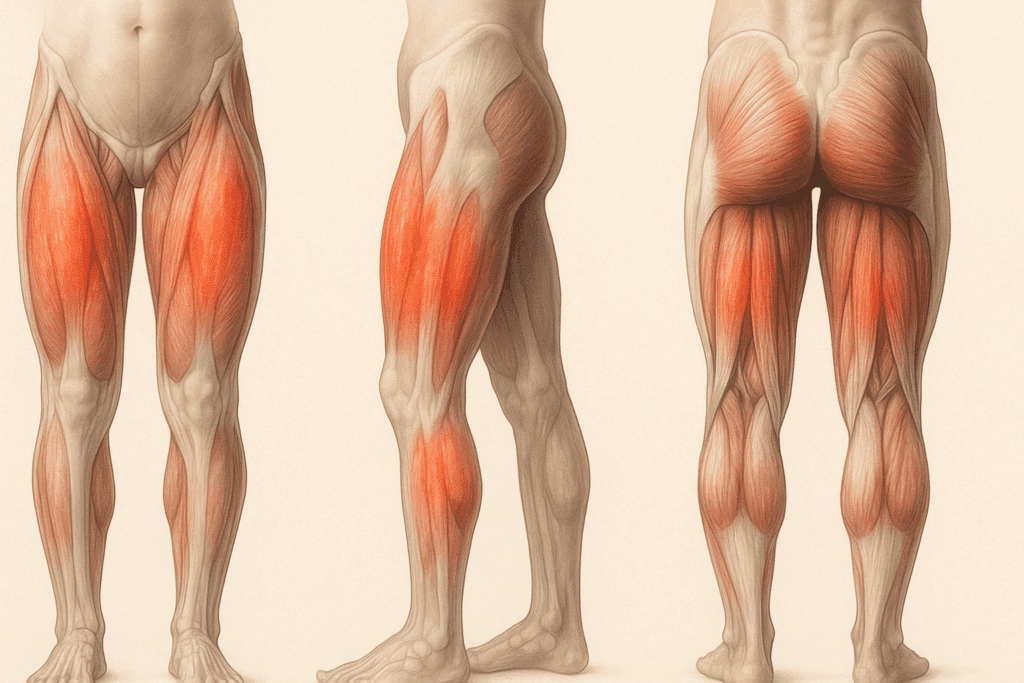
Understanding the Causes of Sore Legs and Tight Thighs
Sore legs and thigh tightness arise from multiple overlapping causes, and discerning the root of discomfort is essential for effective relief. A common source of soreness is delayed onset muscle soreness (DOMS), which typically sets in 24 to 48 hours after intense physical activity. This form of muscle fatigue results from micro-tears in muscle fibers, particularly when movements involve eccentric contractions such as downhill walking or lowering into a squat. While this is a natural response to unfamiliar or intense activity, it creates a sensation of tightness and tenderness that can benefit greatly from targeted thigh stretches for sore muscles.
On the other hand, tight thigh muscles may stem from prolonged periods of inactivity, such as sitting for hours at a time. This is especially common in office settings or during travel, where the hip flexors and quadriceps remain shortened for extended durations. Over time, this shortening leads to decreased mobility, stiffness, and a predisposition to discomfort and injury. In such cases, incorporating stretches for upper thigh tightness into your routine can help restore proper muscle length and joint function.
Injury and muscular imbalance also contribute to thigh pain. Overuse injuries like iliotibial band syndrome or quadriceps strain can present as localized pain and tightness, necessitating careful rehabilitation that includes stretching front of thigh and related muscle groups. Moreover, poor posture, inadequate warm-up, or structural issues in the hips or lower back may contribute to secondary thigh pain, emphasizing the need for a comprehensive stretching approach.
Why Stretching Is Key to Recovery and Prevention
Stretching does far more than ease tension momentarily. When practiced regularly, it supports the long-term health and functionality of the muscles, joints, and connective tissue. Engaging in consistent stretching exercises for thigh pain improves muscle elasticity, enhances blood flow, and promotes the efficient removal of metabolic waste products that accumulate during physical activity. These physiological benefits collectively aid in speeding up recovery while reducing the risk of injury.
For individuals dealing with sore legs exercise routines, integrating targeted stretches helps reset muscle length and function, minimizing imbalances that often lead to discomfort. This is particularly important for those experiencing upper thigh pain relief exercises, where neglected hip flexors or quadriceps may silently impair range of motion until tightness becomes chronic. Stretching also has neurological effects, such as reducing the excitability of motor neurons, which in turn diminishes the perception of tightness and pain.
In addition, stretching functions as a preventive strategy. Regularly lengthening the muscles, especially after exercise or sedentary periods, supports optimal alignment and load distribution across joints. This makes the body more resilient during movement, lowering the risk of strains and overuse injuries. For those wondering how to relax tight thigh muscles naturally, establishing a thoughtful stretching habit is a reliable first step toward sustained relief.

Thigh Muscle Anatomy: Knowing What to Target
To effectively relieve thigh pain, it is important to understand the primary muscle groups involved in the upper leg. The front of the thigh, known as the anterior compartment, houses the quadriceps femoris group, which includes the rectus femoris, vastus lateralis, vastus medialis, and vastus intermedius. These muscles work together to extend the knee and flex the hip, and they are frequently involved in tightness and soreness due to their central role in walking, running, cycling, and climbing.
The posterior thigh contains the hamstrings—a group composed of the biceps femoris, semitendinosus, and semimembranosus. These muscles are responsible for knee flexion and hip extension and often experience tension from activities like sprinting or poor posture. While hamstring tightness is commonly discussed, many people overlook the impact of tight quadriceps, which can lead to anterior pelvic tilt, low back pain, and compromised movement efficiency.
Lateral and medial thigh muscles, including the tensor fasciae latae (TFL), sartorius, gracilis, and adductors, also play significant roles in stabilizing the leg and facilitating multi-directional movement. Tightness or weakness in these muscles may lead to compensatory strain, making stretches for upper leg pain essential for overall leg function. Understanding which muscles are sore or tight helps determine the best leg stretches for sore legs based on individual needs and activity levels.
The Role of Fascia in Thigh Pain and Tightness
Fascia is a dense connective tissue that envelops muscles, nerves, and organs. It plays a vital role in force transmission, structural support, and movement efficiency. When fascia becomes restricted due to overuse, dehydration, or trauma, it can limit mobility and contribute to tight thighs and discomfort. This fascial restriction often leads to sensations that stretching alone cannot fully alleviate.
Incorporating myofascial release techniques, such as foam rolling and massage, targets the fascial layers and encourages the release of adhesions or trigger points. Foam rolling the quadriceps, inner thighs, and IT band helps restore fascial glide and improve tissue hydration. Practicing these techniques before or after stretching exercises for thigh pain can increase the effectiveness of each stretch by reducing fascial resistance and enhancing muscle pliability.
How to Stretch Your Upper Front Thigh: Principles and Technique
Stretching the upper front thigh requires more than simply pulling the foot toward the glutes. Proper technique ensures the stretch targets the quadriceps without compromising the lower back or hip joints. Begin by standing tall, bending one knee, and gently drawing the foot behind you while keeping the knees aligned. Engage the core and tuck the pelvis slightly to prevent lumbar extension. This creates a focused stretch along the rectus femoris, which spans both the hip and knee joints.
To deepen the stretch and incorporate dynamic elements, consider lunging with the rear knee on the ground, then pressing the hips forward while maintaining an upright spine. This variation not only lengthens the front thigh but also stretches the hip flexors, which often contribute to upper thigh tightness. For those with balance limitations or knee sensitivity, performing the stretch on a mat or holding onto a stable surface provides support without sacrificing form.
It’s important to hold each stretch for at least 30 seconds and repeat two to three times per leg. Stretching front of thigh muscles should never be rushed or forced. Gentle, sustained tension allows the muscle fibers and fascia to gradually elongate, minimizing the risk of strain. Deep breathing further enhances the effect by promoting relaxation and increasing parasympathetic nervous system activity.
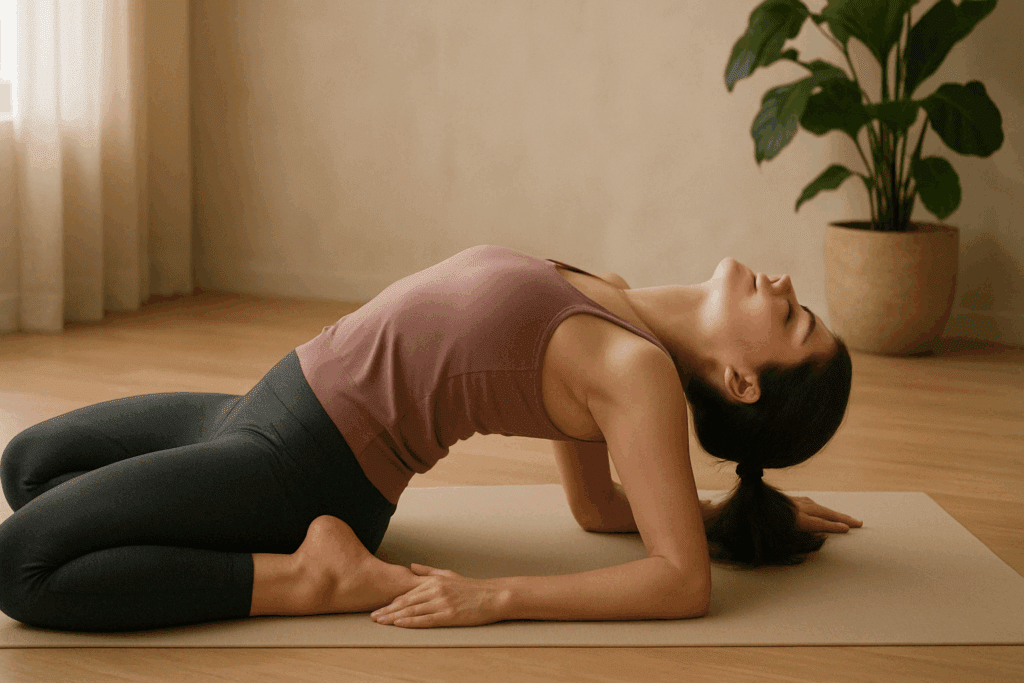
Effective Stretches for Sore Legs and Thigh Pain
Several stretches have proven particularly effective for relieving sore legs and thigh tightness. One essential movement is the standing quadriceps stretch, which directly targets the front thigh. By bending one knee and drawing the heel toward the glutes, the stretch emphasizes flexibility in the rectus femoris and vasti muscles. As mentioned earlier, pelvic alignment is crucial here to avoid compensatory strain in the lumbar spine.
Another beneficial position is the reclining hero pose, a yoga-based stretch that lengthens the quadriceps and opens the hip flexors. Begin in a kneeling position with knees together and feet apart, then gently recline backward until a stretch is felt in the front thighs. This movement is especially effective for those seeking deeper flexibility in the anterior hip and thigh complex.
For lateral thigh tension, the IT band stretch and figure-four position help alleviate tightness along the outer leg. Medial thigh tightness, which often results from limited adductor flexibility, can be relieved with butterfly stretches or wide-legged forward folds. These movements are particularly helpful for restoring symmetry and reducing inner thigh strain. When incorporating these movements, remember that good stretches for sore legs involve consistent, mindful practice rather than aggressive pushing.
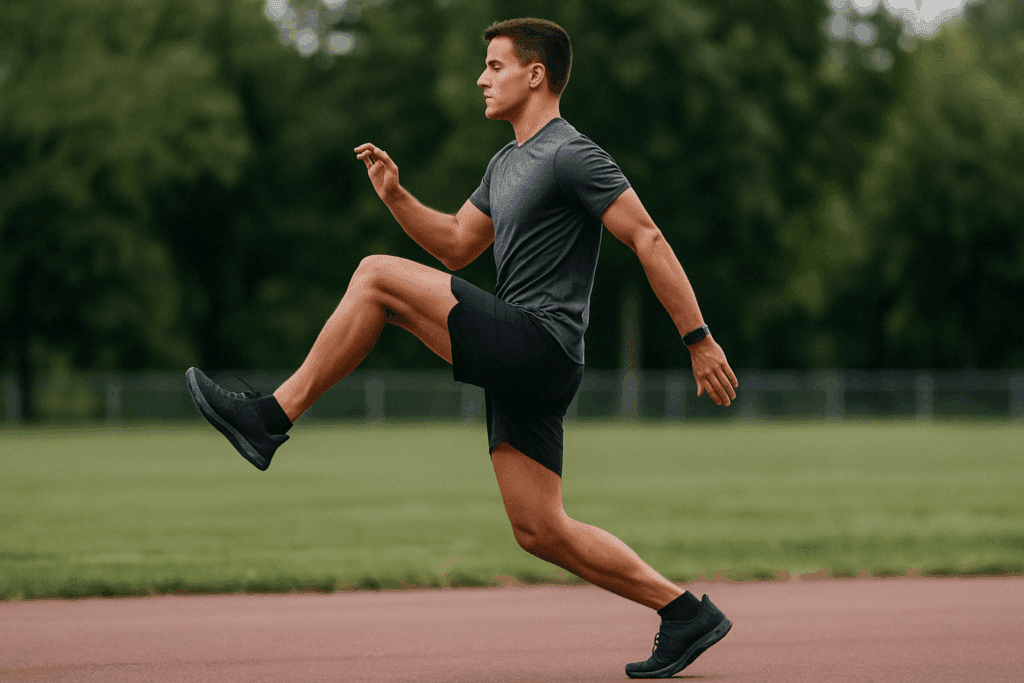
How to Relieve Upper Leg Pain with Dynamic Movement
While static stretching plays a central role in reducing tightness, dynamic stretching can further enhance mobility and circulation. Incorporating controlled leg swings, walking lunges, and knee-to-chest motions before workouts prepares the muscles for activity and reduces the likelihood of injury. These movements mimic the natural range of motion needed in sports and daily tasks, making them an essential part of any sore legs exercise recovery protocol.
Dynamic stretches activate muscle fibers through their full length while improving joint lubrication. For instance, front leg swings help stretch front thigh muscles and activate the hip flexors simultaneously, preparing the legs for higher intensity work. Likewise, side lunges increase mobility in the adductors and inner thighs, reducing tension that can contribute to leg soreness. These active motions are ideal as part of a warm-up or transition between sedentary periods and movement.
Using foam rolling in tandem with dynamic movement can also yield powerful results. Foam rolling the quadriceps, IT band, and hamstrings helps break up adhesions in the fascia, increasing tissue pliability and improving blood flow. This self-myofascial release technique is particularly effective when performed before and after stretching exercises for thigh pain, as it complements the muscle-lengthening effects of flexibility work.
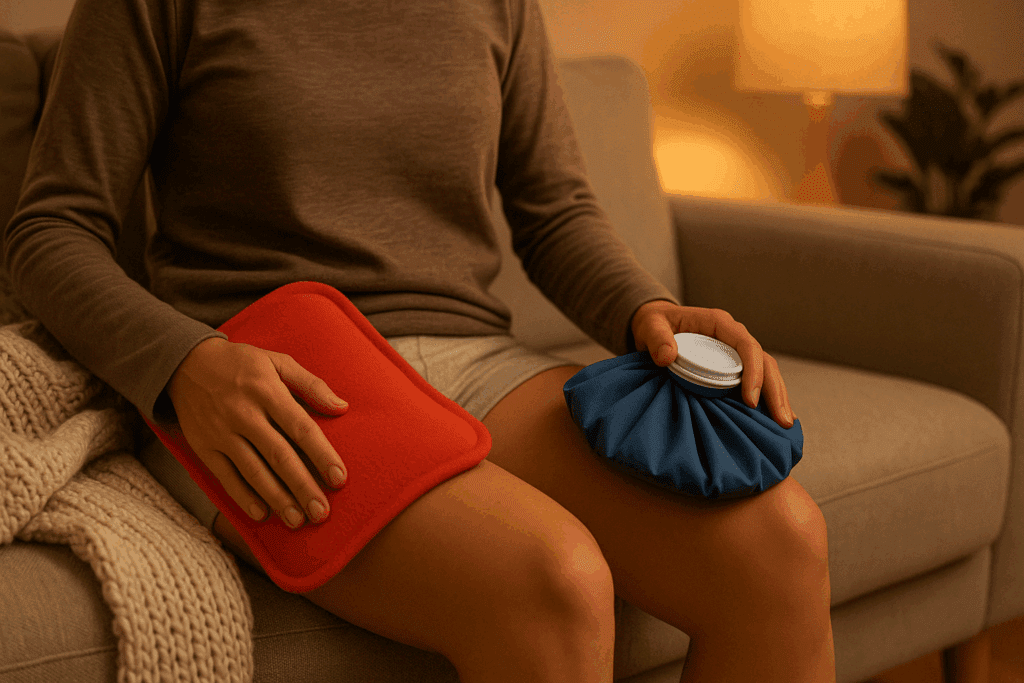
Heat and Cold Therapy for Muscle Soreness and Tension
Thermotherapy and cryotherapy provide another layer of support in managing soreness and tightness. Heat application increases blood flow, promotes tissue relaxation, and facilitates nutrient delivery to the muscles. It is particularly effective for chronic tight thigh muscles or stiffness related to sedentary behavior. Heating pads, warm baths, and infrared saunas are common methods of delivering therapeutic warmth to the upper legs.
Conversely, cold therapy is beneficial for acute soreness and inflammation. Ice packs or cold compresses can reduce muscle swelling and blunt nerve activity, providing pain relief. Alternating between heat and cold, a practice known as contrast therapy, may enhance circulation and promote healing by stimulating vascular responsiveness. Using these methods alongside thigh stretches for soreness can further reduce discomfort and support recovery.
Posture and Ergonomics in Thigh Health
Prolonged sitting, poor spinal alignment, and inadequate support can all contribute to tightening thigh muscles. When the hips remain flexed for extended periods, such as during desk work or driving, the quadriceps and hip flexors adaptively shorten, leading to restricted range of motion and eventual discomfort.
To counteract these effects, incorporating ergonomic principles into daily life is essential. Adjusting the height of chairs and desks, using lumbar support, and periodically standing or walking can alleviate undue tension. Regular posture checks and mindful body mechanics prevent structural adaptations that lead to thigh pain. These corrections, when paired with how to stretch top of thigh techniques, create a more sustainable environment for musculoskeletal health.
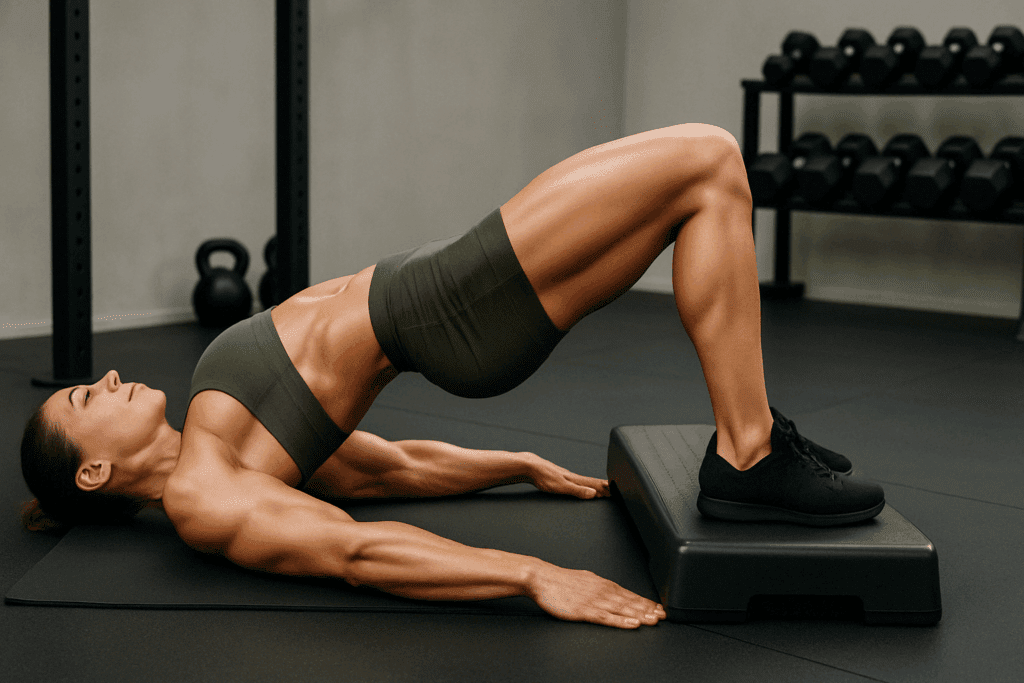
Upper Thigh Pain Relief Exercises for Recovery and Resilience
When upper thigh pain is persistent or recurrent, strengthening exercises often provide long-term relief by correcting imbalances and improving tissue resilience. Glute bridges, step-ups, and resistance band walks activate the posterior chain, which helps offload overworked quadriceps and hip flexors. These movements balance muscle activation around the hip and knee joints, promoting joint integrity and sustainable function.
Eccentric-focused movements like slow squats and lunges are particularly beneficial for sore legs. Eccentric contractions lengthen the muscle under tension, a process that builds strength while reducing injury risk. When performed with control and followed by proper stretching, these exercises support structural adaptation and reduce the frequency of tight thigh muscles.
Isometric holds, such as wall sits, also help develop endurance in the thigh muscles without placing excessive strain on sensitive joints. Incorporating these exercises as part of a broader rehabilitation or preventive routine ensures that the legs remain strong, mobile, and less prone to chronic discomfort. Knowing how to relieve upper leg pain through both stretching and strengthening enhances overall movement efficiency and quality of life.
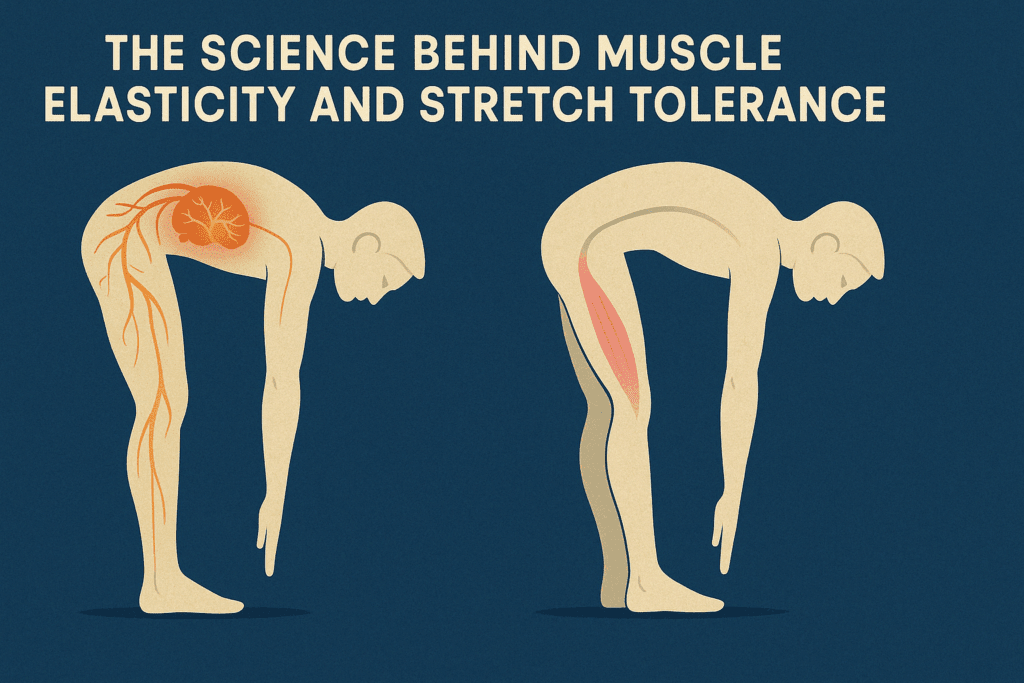
The Science Behind Muscle Elasticity and Stretch Tolerance
Recent research has expanded our understanding of how muscles adapt to stretching. Studies show that improvements in flexibility are often the result of increased stretch tolerance rather than permanent changes in muscle length. This means that with regular stretching and relaxation training, the nervous system becomes less reactive to muscle elongation, reducing discomfort and allowing for deeper, safer stretching.
This neural adaptation explains why some individuals notice rapid improvements in range of motion after consistently practicing good stretches for sore legs. It also reinforces the importance of consistency over intensity. Aggressive stretching can trigger a protective reflex, known as the stretch reflex, which may increase muscle tightness rather than alleviate it.
For those learning how to stretch front thigh muscles, understanding the role of the nervous system helps refine technique and timing. Gentle, sustained holds combined with calm breathing are more effective than forceful bouncing or overstretching. With time, the body recalibrates its tolerance, and chronic tightness begins to subside.
The Importance of Frequency, Consistency, and Recovery
Stretching once or twice after a workout may bring temporary relief, but lasting results require consistency and intentionality. Muscles adapt to the stimuli they receive, and regular practice of leg stretches for leg pain conditions the tissues to maintain their new, lengthened state. Ideally, stretching should be integrated daily or at least five days per week to maximize its benefits, especially during periods of increased activity or postural stress.
Each session should be tailored to the body’s current needs, factoring in soreness levels, fatigue, and mobility goals. It’s crucial not to overstretch, particularly when dealing with acute soreness or injury. A gradual, progressive approach allows the body to adapt without creating new strain. Additionally, pairing stretching with adequate hydration, sleep, and anti-inflammatory nutrition accelerates recovery and supports overall muscle health.
Using visualization and breathwork during stretching can also improve outcomes. Visualizing the muscle lengthening and breathing deeply into areas of tension encourages mental and physical relaxation. This approach aligns with the mind-body principles found in yoga and physical therapy, further validating the holistic power of stretching as a recovery and wellness tool.
Frequently Asked Questions (FAQ): Stretching for Sore Legs and Tight Thigh Muscles
1. How can I prevent tight thigh muscles from becoming a chronic issue?
Chronic tight thigh muscles often result from a combination of repetitive movement patterns and prolonged inactivity. One effective strategy is to build a consistent mobility routine that alternates between dynamic and static stretches. For example, using stretches for upper thigh tightness in the morning and incorporating stretching front of thigh exercises post-workout can significantly improve tissue length and reduce recurrence. Additionally, incorporating active recovery days with light aerobic activity, such as walking or swimming, helps prevent muscular shortening and enhances circulation. Over time, this integrated approach can prevent tightening thigh muscles from limiting your range of motion or causing persistent soreness.
2. What role does muscle activation play in relieving tight thighs?
Many people focus solely on flexibility without considering muscle engagement, but activating underused muscles can provide long-term relief for tight thighs. When muscles like the glutes or core are weak, the thigh muscles overcompensate, leading to overuse and tightness. By combining thigh stretches for sore muscles with strength training for complementary muscle groups, you encourage balanced movement and joint stability. For instance, pairing stretching exercises for thigh pain with glute bridges or core planks addresses both tightness and underlying imbalances. This dual-focus method can be especially beneficial when learning how to relieve upper leg pain holistically.
3. Are there specific breathing techniques that enhance the effectiveness of stretches for sore legs?
Yes, incorporating mindful breathing can amplify the benefits of stretches for sore legs and tight thigh muscles. Slow, deep inhalations followed by prolonged exhalations help activate the parasympathetic nervous system, which encourages muscular relaxation. When performing an upper thigh stretch, syncing your breath with movement allows deeper tissue release and prevents compensatory tension. Box breathing or 4-7-8 techniques can be practiced while holding stretches for leg pain, fostering both physical and mental relaxation. These practices not only help with how to relax tight thigh muscles but also make your recovery sessions more meditative and restorative.
4. Can posture correction support upper thigh pain relief exercises?
Absolutely. Poor posture—especially anterior pelvic tilt or a rounded lumbar spine—can perpetuate thigh tightness and pain. Postural correction exercises, such as pelvic tilts and thoracic extensions, complement stretching for sore thighs by promoting better muscle alignment. When posture is optimized, stretching front of thigh muscles becomes more effective because the body isn’t compensating for imbalances. A well-aligned posture also enhances the efficacy of thigh pain exercises by ensuring targeted muscles are fully engaged. This synergy between posture and mobility often marks a turning point for those dealing with chronic upper thigh discomfort.
5. Are there lesser-known tools that enhance leg stretches for leg pain?
In addition to foam rollers and yoga blocks, tools like mobility balls, PNF (proprioceptive neuromuscular facilitation) straps, and resistance bands can significantly deepen leg stretches for leg pain. For instance, using a resistance band to assist a hamstring or quadriceps stretch allows controlled tension and better range of motion. PNF stretching—where you contract and then release the muscle being stretched—can be especially useful for stubborn tight thighs. These tools can also help maintain alignment during good stretches for sore legs, minimizing the risk of compensation or joint strain. Incorporating such props provides a richer, more nuanced stretching routine tailored to individual needs.
6. How do emotional factors contribute to persistent thigh tightness?
The mind-body connection plays a surprisingly important role in muscular tension, especially in areas like the hips and thighs, which are common storage sites for stress. Chronic stress activates the sympathetic nervous system, increasing muscle tone even during rest. When emotional stress is high, even the best leg stretches for sore legs may feel ineffective until underlying stress is addressed. Practices like meditation, journaling, and breath-based yoga help calm the nervous system and make stretches for thigh pain more impactful. Addressing both physical and emotional contributors provides a more sustainable strategy for how to relax tight thigh muscles over the long term.
7. What are some mistakes to avoid when doing thigh stretches for soreness?
A common error is rushing through the stretch or using excessive force, which can trigger a protective muscle response and actually increase tightness. Another mistake is neglecting the rest of the kinetic chain—tight calves, hips, or even shoulders can affect how well you perform stretches for thigh pain. It’s also important not to stretch cold muscles; warming up with light movement ensures your stretching exercises for thigh pain are both safe and effective. Additionally, holding your breath or ignoring postural alignment during an upper thigh stretch may limit results and cause discomfort. By focusing on proper technique, you optimize both safety and results when using thigh stretches for soreness.
8. How can I modify stretches for sore legs if I have limited mobility or joint issues?
Limited mobility doesn’t mean you can’t perform effective stretches for leg soreness—it just requires thoughtful adjustments. Chair-based variations, such as seated hamstring stretches or supported lunges, allow for gentle lengthening without stressing joints. For those with knee sensitivity, lying on your side or back while stretching front of thigh muscles reduces weight-bearing pressure. Using props for support ensures you can still engage in the best stretches for sore legs without risking joint discomfort. These adaptations make sore legs exercise routines accessible and safe for older adults, post-injury individuals, or anyone with mobility constraints.
9. What’s the difference between passive and active stretching for sore thighs?
Passive stretching involves using gravity, props, or external assistance to hold a stretch, while active stretching requires you to contract opposing muscles to deepen the stretch. Both methods are useful, but active stretching may offer greater functional benefits by increasing strength and flexibility simultaneously. For example, when learning how to stretch your upper front thigh, actively engaging the glutes while extending the hip offers a more integrated, long-lasting result. Passive methods are ideal for cooling down or relaxing after exercise for leg pain. By alternating between the two styles, you can personalize your flexibility program to meet varying recovery needs.
10. How does sleep impact the recovery of tight thigh muscles?
Sleep plays a critical role in muscle repair and tissue regeneration. Growth hormone, which aids in muscle recovery, is primarily released during deep sleep stages. Inadequate or poor-quality sleep can prolong soreness and limit the effectiveness of thigh stretches for sore muscles. For those following upper thigh pain relief exercises, establishing a consistent sleep routine enhances recovery by supporting hormone regulation and cellular repair. In essence, learning how to relieve upper leg pain isn’t just about stretching—it also involves honoring your body’s need for rest and recovery during sleep.
Conclusion : Best Leg Stretches for Sore Legs and Thigh Tightness
Understanding how to stretch front thigh muscles, relieve tight thighs, and ease upper leg pain safely and naturally involves more than isolated movements—it requires a commitment to mindful, consistent self-care. Whether you’re grappling with soreness after intense activity or looking for relief from postural stiffness, the best stretches for sore legs are those performed regularly, correctly, and with attention to how your body responds.
Stretching for sore thighs and tight thigh muscles provides an accessible, effective method to reduce discomfort, enhance mobility, and prevent future pain. Integrating stretching front of thigh exercises, dynamic warm-ups, and strength-based recovery strategies into your routine ensures not only relief but also resilience. Knowing how to relax tight thigh muscles and how to stretch your upper front thigh enables you to stay active, agile, and pain-free across all stages of life.
By making stretching a regular habit, supported by proper form and recovery, you’re investing in long-term mobility and comfort. The path to relieving upper leg pain doesn’t require complicated interventions or high-cost treatments. It starts with simple, deliberate movement—and a deepened awareness of what your body truly needs to heal, strengthen, and thrive.
Was this article helpful? Don’t let it stop with you. Share it right now with someone who needs to see it—whether it’s a friend, a colleague, or your whole network. And if staying ahead on this topic matters to you, subscribe to this publication for the most up-to-date information. You’ll get the latest insights delivered straight to you—no searching, no missing out.
Further Reading:
Sore After Leg Day? Try These 8 Stretches


